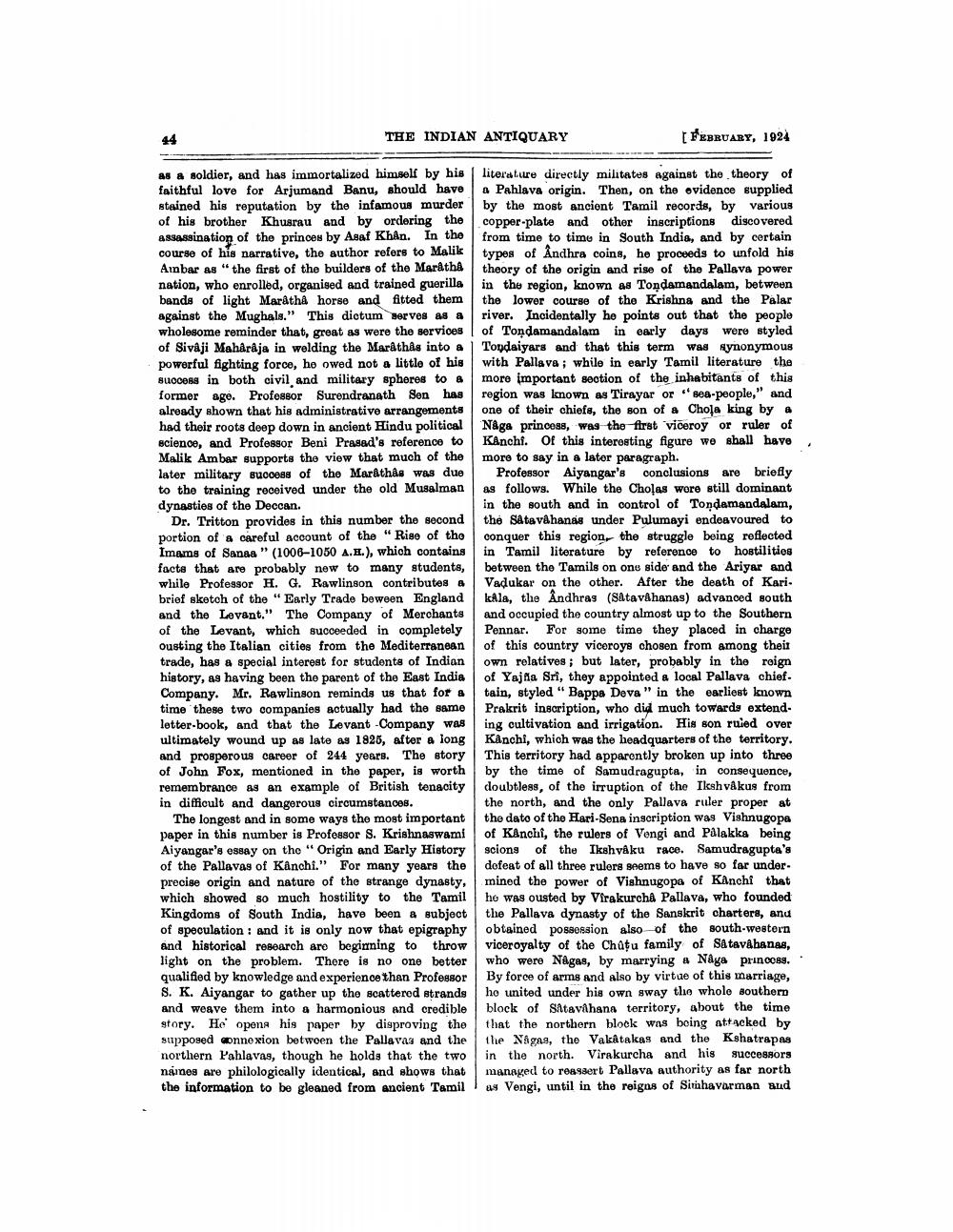________________
44
THE INDIAN ANTIQUARY
[ FEBRUARY, 1924
As a soldier, and has immortalized himself by his literature directly militates against the theory of faithful love for Arjumand Banu, should have a Pahlava origin. Then, on the evidence supplied stained his reputation by the infamous murder by the most ancient Tamil records, by various of his brother Khusrau and by ordering the copper-plate and other inscriptions discovered 883&ssination of the princes by Asaf Khån. In the from time to timu in South India, and by certain course of his narrative, the author refers to Malik types of Andhra coins, he proceeds to unfold his Aibar as "the first of the builders of the Marathả theory of the origin and rise of the Pallava power nation, who enrolled, organised and trained guerilla in the region, known as Tondamandalam, between bands of light Maratha horse and fitted them the lower course of the Krishna and the Palar against the Mughals." This dictum serves as a river. Incidentally he points out that the people wholesome reminder that, great as were the services of Tondamandalam in early days were styled of Sivaji Maharaja in welding the Marathis into a Tondaiyars and that this term was synonymous powerful fighting force, he owed not a little of his with Pallava; while in early Tamil literature the success in both civil and military spheres to & more important section of the inhabitants of this former age. Professor Surendranath Sen has region was known as Tirayar or sea-people," and already shown that his administrative arrangements one of their chiefs, the son of a Chola king by a had their roots deep down in ancient Hindu political Någa princess, was the first viceroy or ruler of science, and Professor Beni Prasad's reference to Kanchi. Of this interesting figure we shall have Malik Ambar supports the view that much of the more to say in a later paragraph. later military success of the Markthås was due Professor Aiyangar's conclusions are briefly to the training received under the old Musalman as follows. While the Cholas were still dominant dynasties of the Deccan.
in the south and in control of Tondamandalam, Dr. Tritton provides in this number the second the Satavahanas under Pulumayi endeavoured to portion of a careful account of the "Rise of the conquer this region, the struggle being reflected Imams of Sanaa " (1006-1050 A.H.), which contains in Tamil literature by reference to hostilities facts that are probably new to many students, between the Tamils on one side and the Ariyar and while Professor H. G. Rawlinson contributes a Vadukar on the other. After the death of Kari. brief sketch of the "Early Trade beween England kala, the Andhras (Satavahanas) advanced south and the Levant." The Company of Merchants and occupied the country almost up to the Southern of the Levant, which succeeded in completely Pennar. For some time they placed in charge Ousting the Italian cities from the Mediterranean of this country viceroys chosen from among their trade, has a special interest for students of Indian own relatives; but later, probably in the reign history, as having been the parent of the East India of Yajna Sri, they appointed a local Pallava chief. Company. Mr. Rawlinson reminds us that for a tain, styled "Bappa Deva" in the earliest known time these two companies actually had the same Prakrit inscription, who did much towards extend. letter-book, and that the Levant Company wasing cultivation and irrigation. His son ruled over ultimately wound up as late as 1825, after a long Kanchi, which was the headquarters of the territory. and prosperous career of 244 years. The story This territory had apparently broken up into three of John Fox, mentioned in the paper, is worth by the time of Samudragupta, in consequence, remembrance as an example of British tenacity doubtless, of the irruption of the Iksh vâkus from in difficult and dangerous circumstances.
the north, and the only Pallava ruler proper at The longest and in some ways the most important the dato of the Hari-Sena inscription was Vishnugopa paper in this number is Professor S. Krishnaswami of Kanchi, the rulers of Vengi and Palakka being Aiyangar's essay on the "Origin and Early History scions of the Ikshyâku race. Samudragupta's of the Pallavas of Kanchi." For many years the defeat of all three rulers seems to have so for under. precise origin and nature of the strange dynasty, mined the power of Vishnugopa of Kanchi that which showed so much hostility to the Tamil he was ousted by Virakurchi Pallava, who founded Kingdoms of South India, have been a subject the Pallava dynasty of the Sanskrit charters, and of speculation : and it is only now that epigraphy obtained possession also of the south-western and historical research are beginning to throw viceroyalty of the Chatu family of Satavahanas, light on the problem. There is no one better who were Nagas, by marrying « Naya prino88. qualified by knowledge and experience than Professor By force of arms and also by virtue of this marriage, S. K. Aiyangar to gather up the scattered strands ho united under his own gway the whole southern and weave them into a harmonious and credible block of Satavahana territory, about the time story. He opens his paper by disproving the that the northern block was being attacked by supposed connexion between the Pallavas and the the Nigns, the Vakatakas and the Kshatrapas northern Pahlavas, though he holds that the two in the north. Virakurcha and his successors names are philologically identical, and shows that managed to rossaert Pallava authority as far north the information to be gleaned from ancient Tamil Vengi, until in the reigns of Sitahavarman aud




